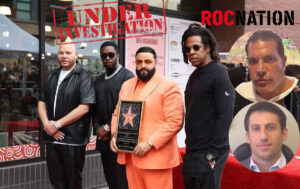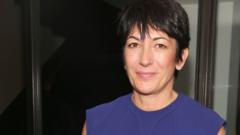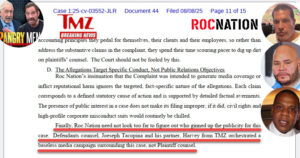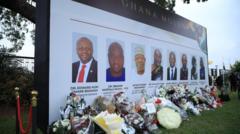In a dramatic turn of events, former Abercrombie & Fitch CEO Mike Jeffries has been arrested and charged with sex trafficking, thanks to an in-depth investigation by a BBC journalist. This probe, spanning three years, began when journalist Rianna Croxford stumbled upon an Instagram comment discussing abuse within the male modeling industry. The investigation revealed a disturbing network of exploitation involving young men, orchestrated by Jeffries and his partner Matthew Smith, who have been accused of coercing and abusing vulnerable individuals. As the case aspires to bring justice, it serves as a reminder of the ongoing fight against exploitation in the fashion industry.
Ex-Abercrombie CEO Faces Justice After Sex Trafficking Investigation

Ex-Abercrombie CEO Faces Justice After Sex Trafficking Investigation
A BBC investigation unveils the shocking reality behind alleged sex trafficking involving former Abercrombie & Fitch CEO Mike Jeffries and his associates.
In a federal courtroom in New York, the air was thick with tension as I stood opposite Mike Jeffries, the former CEO of Abercrombie & Fitch, who has been the focus of my investigation for over three years. My journalism led to his arrest this week by the FBI on charges of running an international sex trafficking ring, alongside his associate Matthew Smith, and their operative, James Jacobson. This investigation was sparked by my podcast series, "The Abercrombie Guys," where I uncovered evidence indicating that Jeffries and Smith were implicated in a far-reaching illicit operation that sought out young men for sexual exploitation under the guise of modeling work.
As I observed Jeffries, whose glamorous and iconic appearance had faded into a stark reality marked by an ankle monitor and a deflated sense of power, I reflected on his history. Once a celebrated figure in the fashion industry, he now faces a bleak future as U.S. prosecutors present damning evidence against him and the others involved. Allegations date back from 2008 to 2015, accusing them of using manipulation and intimidation to compel young men into sexual acts. The potential for life imprisonment looms if they are convicted.
The seeds of this investigation were planted in January 2021 during the onset of the pandemic. While scrutinizing the fashion landscape, I encountered a poignant comment from Barrett Pall, a former model, lamenting the silence surrounding abuse in the industry. His words resonated deeply, leading him to share a harrowing secret from his past involving Jeffries. It's a narrative filled with severe emotional and physical trauma that countless others have tragically endured.
I embarked on a journey across the United States, speaking to numerous men who, like Barrett, had encountered Jeffries and were impacted by the systemic abuse that many felt compelled to suppress. My investigation revealed firsthand accounts of betrayal and fear; many men were cautious to speak due to fears of repercussions from Jeffries' powerful network.
Through relentless investigative work involving detailed conversations, document recovery, and piecing together a host of sources, I uncovered shocking testimonies and validated evidence surrounding these alleged events. An old iPad belonging to Pall became a crucial piece of evidence, revealing itineraries and plans tied to the clandestine gatherings that served as a front for trafficking.
These revelations culminated in a groundbreaking expose, and soon the descriptions of coercion and complicity began to envelop the narrative surrounding Jeffries and Smith. Remarkably, the institutional cover-ups embedded within the industry emerged, reflecting deep-seated stigma surrounding male victims of sexual exploitation.
In the wake of revealing this dark reality, numerous men have begun lawsuits against Jeffries, Smith, and Abercrombie & Fitch, alleging rape, assault, and trafficking. With over 100 victims estimated to be involved, the implications of this case extend far beyond mere allegations; it points to a deep societal reckoning within the fashion world.
For many victims, speaking out represents a hope for justice and catharsis, even as they confront the haunting memories of their experiences. As the legal proceedings advance, the voices of the abused are being amplified, laying bare the urgent need for reform in industries that have long operated in shadows.
U.S. attorney Breon Peace encapsulated this growing movement against exploitation, warning those complicit with a firm assertion that they may soon trade their power for a prison cell. This case is more than an indictment; it serves as a reflection of the ongoing societal demand for accountability and protection against abuses of authority.
As I observed Jeffries, whose glamorous and iconic appearance had faded into a stark reality marked by an ankle monitor and a deflated sense of power, I reflected on his history. Once a celebrated figure in the fashion industry, he now faces a bleak future as U.S. prosecutors present damning evidence against him and the others involved. Allegations date back from 2008 to 2015, accusing them of using manipulation and intimidation to compel young men into sexual acts. The potential for life imprisonment looms if they are convicted.
The seeds of this investigation were planted in January 2021 during the onset of the pandemic. While scrutinizing the fashion landscape, I encountered a poignant comment from Barrett Pall, a former model, lamenting the silence surrounding abuse in the industry. His words resonated deeply, leading him to share a harrowing secret from his past involving Jeffries. It's a narrative filled with severe emotional and physical trauma that countless others have tragically endured.
I embarked on a journey across the United States, speaking to numerous men who, like Barrett, had encountered Jeffries and were impacted by the systemic abuse that many felt compelled to suppress. My investigation revealed firsthand accounts of betrayal and fear; many men were cautious to speak due to fears of repercussions from Jeffries' powerful network.
Through relentless investigative work involving detailed conversations, document recovery, and piecing together a host of sources, I uncovered shocking testimonies and validated evidence surrounding these alleged events. An old iPad belonging to Pall became a crucial piece of evidence, revealing itineraries and plans tied to the clandestine gatherings that served as a front for trafficking.
These revelations culminated in a groundbreaking expose, and soon the descriptions of coercion and complicity began to envelop the narrative surrounding Jeffries and Smith. Remarkably, the institutional cover-ups embedded within the industry emerged, reflecting deep-seated stigma surrounding male victims of sexual exploitation.
In the wake of revealing this dark reality, numerous men have begun lawsuits against Jeffries, Smith, and Abercrombie & Fitch, alleging rape, assault, and trafficking. With over 100 victims estimated to be involved, the implications of this case extend far beyond mere allegations; it points to a deep societal reckoning within the fashion world.
For many victims, speaking out represents a hope for justice and catharsis, even as they confront the haunting memories of their experiences. As the legal proceedings advance, the voices of the abused are being amplified, laying bare the urgent need for reform in industries that have long operated in shadows.
U.S. attorney Breon Peace encapsulated this growing movement against exploitation, warning those complicit with a firm assertion that they may soon trade their power for a prison cell. This case is more than an indictment; it serves as a reflection of the ongoing societal demand for accountability and protection against abuses of authority.





















